History
Construction of the cathedral began as early as 1170 by an original unknown master mason, for the use of the Catholic Church. Twenty years later, another master mason restarted construction until 1215. Finally a third engineer, Jean Cotereel, completed the majority of the existing cathedral including a porch, and two towers, one of which is the current day belfry. The other tower was never completed. The cathedral was consecrated and dedicated to Our Lady in 1275 by Pope Gregory X, Rudolph of Habsburg, and the bishop of Lausanne at the time, Guillaume of Champvent. [1] The medieval architect Villard de Honnecourt drew the rose window of the south transept in his sketchbook around 1220-1230.
The Protestant Reformation, in particular the variant which came from nearby Geneva, significantly affected the cathedral, with it eventually being turned over to a Protestant denomination. In 1536, a new liturgical area was added to the nave and the colourful decorations inside the cathedral were covered over. Other major restorations occurred later in the 18th and 19th century which were directed by the great French architect, Eugène Viollet-le-Duc. [2] During the 20th century major restorations occurred to restore the painted interior decorations as well as to restore a painted portal on the South side of the cathedral. New organs were installed in 2003.
The cathedral, from
Le Flon South rose window
Inside, from the chancel
View from the tower
The Cathedral in 1793

Lausanne is the capital and largest city of the Swiss French-speaking canton of Vaud. It is a hilly city situated on the shores of Lake Geneva, about halfway between the Jura Mountains and the Alps, and facing the French town of Évian-les-Bains across the lake. Lausanne is located 62 kilometres northeast of Geneva, the nearest major city.
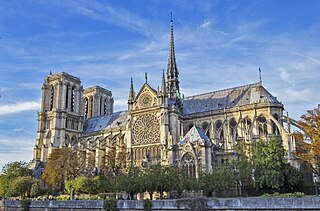
Notre-Dame de Paris, referred to simply as Notre-Dame, is a medieval Catholic cathedral on the Île de la Cité, in the 4th arrondissement of Paris, France. The cathedral, dedicated to the Virgin Mary, is considered one of the finest examples of French Gothic architecture. Several attributes set it apart from the earlier Romanesque style, particularly its pioneering use of the rib vault and flying buttress, its enormous and colourful rose windows, and the naturalism and abundance of its sculptural decoration. Notre-Dame also stands out for its three pipe organs and its immense church bells.

Auxerre Cathedral is a Roman Catholic church, dedicated to Saint Stephen, located in Auxerre, Burgundy, France. It was constructed between the 13th and 16th centuries, on the site of a Romanesque cathedral from the 11th century, whose crypt is found underneath the cathedral. It is known for 11th century Carolingian frescoes found in the crypt, and for its large stained glass windows. Since 1823 it has been the seat of a diocese united with that of Sens Cathedral.
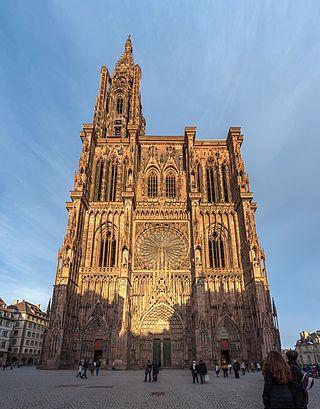
Strasbourg Cathedral or the Cathedral of Our Lady of Strasbourg, also known as Strasbourg Minster, is a Catholic cathedral in Strasbourg, Alsace, France. Although considerable parts of it are still in Romanesque architecture, it is widely considered to be among the finest examples of Rayonnant Gothic architecture. Architect Erwin von Steinbach is credited for major contributions from 1277 to his death in 1318, and beyond through his son Johannes von Steinbach, and his grandson Gerlach von Steinbach, who succeeded him as chief architects. The Steinbachs’ plans for the completion of the cathedral were not followed through by the chief architects who took over after them, and instead of the originally envisioned two spires, a single, octagonal tower with an elongated, octagonal crowning was built on the northern side of the west facade by master Ulrich Ensingen and his successor, Johannes Hültz. The construction of the cathedral, which had started in the year 1015 and had been relaunched in 1190, was finished in 1439.

Rouen Cathedral is a Catholic church in Rouen, Normandy, France. It is the see of the Archbishop of Rouen, Primate of Normandy. It is famous for its three towers, each in a different style. The cathedral, built and rebuilt over a period of more than eight hundred years, has features from Early Gothic to late Flamboyant and Renaissance architecture. It also has a place in art history as the subject of a series of impressionist paintings by Claude Monet, and in architecture history as from 1876 to 1880, it was the tallest building in the world.
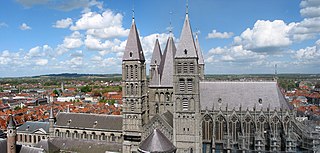
The Cathedral of Our Lady, or Tournai Cathedral, is a Roman Catholic cathedral, see of the Diocese of Tournai in Tournai, Belgium. It has been classified both as a Wallonia's major heritage since 1936 and as a World Heritage Site since 2000.
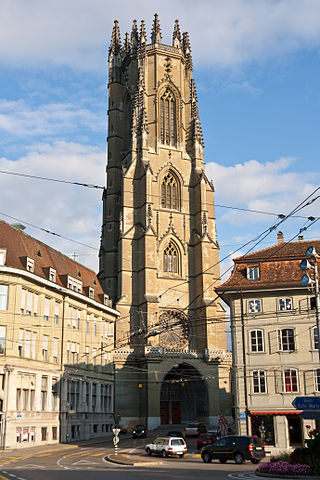
The Diocese of Lausanne, Geneva and Fribourg is a Latin Catholic diocese in Switzerland, which is exempt. The original diocese of Lausanne was a suffragan of the archdiocese of Besançon, through the 18th century. The diocese of Geneva was a suffragan of the archdiocese of Vienne.

Forcalquier Cathedral, now the Church of Notre-Dame-du-Bourguet, is a former Roman Catholic cathedral, and a national monument of France, located in the town of Forcalquier, Alpes-de-Haute-Provence.

Entrevaux Cathedral is a Roman Catholic church and former cathedral in Glandèves, France. It was the seat of the bishops of Glandèves, who moved their principal residence to Entrevaux in the early 17th century. The edifice served as a cathedral from 1624 to 1790, known at the time from the name of the diocese as the Glandèves Cathedral. It is now a parish church.

Rodez Cathedral is a Roman Catholic church located in town of Rodez, in the department of Aveyron in the Occitanie region of Southern France. The cathedral is a national monument and is the seat of the Bishopric of Rodez. The west front, of a military appearance and without a portal, formerly was part of the city wall of Rodez. Notable elements include a Flamboyant Gothic and Renaissance tower, and a Renaissance rood screen and choir stalls.

Saint-Brieuc Cathedral is a Roman Catholic church located in the town of Saint-Brieuc, Brittany, France, and dedicated to Saint Stephen.

Toulouse Cathedral is a Roman Catholic church located in the city of Toulouse, France. The cathedral is a national monument, and is the seat of the Archbishop of Toulouse. It has been listed since 1862 as a monument historique by the French Ministry of Culture.

Fréjus Cathedral is a Roman Catholic church located in the town of Fréjus in the Var department of Provence, southeast France, and dedicated to Saint Leontius of Fréjus.

Évreux Cathedral, otherwise the Cathedral of Our Lady of Évreux, is a Catholic church located in Évreux, Normandy, France. The cathedral is a national monument and is the seat of the Bishop of Évreux.
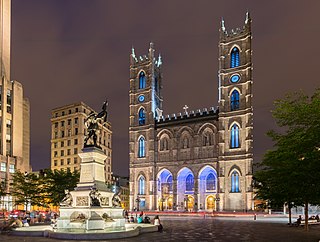
The Notre-Dame Basilica is a basilica in the historic district of Old Montreal, in Montreal, Quebec, Canada. The church is located at 110 Notre-Dame Street West, at the corner of Saint Sulpice Street. It is located next to the Saint-Sulpice Seminary and faces the Place d'Armes square.
Samson Scherrer (1698–1780) was an organ builder in the 18th century.
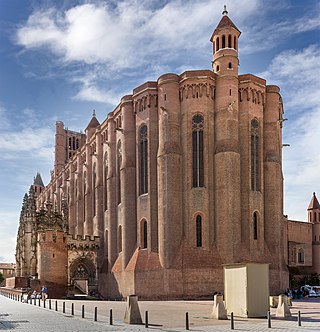
Southern French Gothic, or Meridional Gothic, is a specific and militant style of Gothic architecture developed in the South of France, especially in the Toulouse region. It arose in the early 13th century following the victory of the Catholic church over the Cathars, as the church sought to re-establish its authority in the region. As a result, church buildings typically present features drawn from military architecture. Taking into account the Cathars' criticism of the Catholic Church, Southern French Gothic is simpler and less ornate than northern French Gothic, and further differs in that the construction material is typically brick rather than stone. Over time, the style came to influence secular buildings as well as churches and spread beyond the area where Catharism had flourished.

There are 10 church bells in the cathedral of Notre-Dame de Paris, all of which are mounted in the two main bell towers. Notre-Dame used to have other smaller bells in the spire and within the roof, but these were destroyed in a fire in 2019.
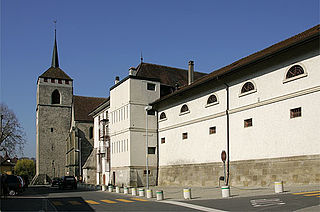
The Reformed Church of Saint-Étienne, also known as the Temple of Saint-Étienne, is a Protestant church located in the municipality of Moudon, canton of Vaud, Switzerland. It is a parish church of the Evangelical Reformed Church of the Canton of Vaud. It is listed as a heritage site of national significance.
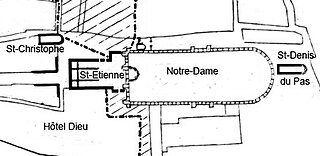
The Basilica and Cathedral of Saint-Étienne in Paris, on the Île de la Cité, was an early Christian church that preceded Notre-Dame de Paris. It was built in the 4th or 5th century, directly in front of the location of the modern cathedral, and just 250 meters from the royal palace. It became one of the wealthiest and most prestigious churches in France. Nothing remains above the ground of the original cathedral. It was demolished beginning in about 1163, when construction began on Notre-Dame de Paris. Vestiges of the foundations remain beneath the pavement of the square in front of Notre-Dame and beneath the west front of the cathedral. The church was built and rebuilt over the years in the Merovingian, Carolingian and Romanesque architectural styles.

























